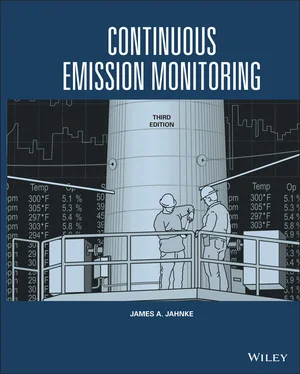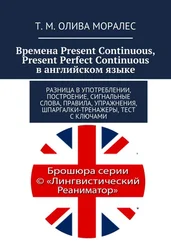James A. Jahnke - Continuous Emission Monitoring
Здесь есть возможность читать онлайн «James A. Jahnke - Continuous Emission Monitoring» — ознакомительный отрывок электронной книги совершенно бесплатно, а после прочтения отрывка купить полную версию. В некоторых случаях можно слушать аудио, скачать через торрент в формате fb2 и присутствует краткое содержание. Жанр: unrecognised, на английском языке. Описание произведения, (предисловие) а так же отзывы посетителей доступны на портале библиотеки ЛибКат.
- Название:Continuous Emission Monitoring
- Автор:
- Жанр:
- Год:неизвестен
- ISBN:нет данных
- Рейтинг книги:4 / 5. Голосов: 1
-
Избранное:Добавить в избранное
- Отзывы:
-
Ваша оценка:
- 80
- 1
- 2
- 3
- 4
- 5
Continuous Emission Monitoring: краткое содержание, описание и аннотация
Предлагаем к чтению аннотацию, описание, краткое содержание или предисловие (зависит от того, что написал сам автор книги «Continuous Emission Monitoring»). Если вы не нашли необходимую информацию о книге — напишите в комментариях, мы постараемся отыскать её.
The new edition of the only single-volume reference on both the regulatory and technical aspects of U.S. and international continuous emission monitoring (CEM) systems Continuous Emission Monitoring
Continuous Emission Monitoring:
Continuous Emission Monitoring, Third Edition
Continuous Emission Monitoring — читать онлайн ознакомительный отрывок
Ниже представлен текст книги, разбитый по страницам. Система сохранения места последней прочитанной страницы, позволяет с удобством читать онлайн бесплатно книгу «Continuous Emission Monitoring», без необходимости каждый раз заново искать на чём Вы остановились. Поставьте закладку, и сможете в любой момент перейти на страницу, на которой закончили чтение.
Интервал:
Закладка:
To lower the cost of CEM systems, CEM system manufacturers are employing multi‐gas techniques to avoid subsystem duplication that occurs when using single‐gas dedicated analyzers. One approach is to use multi‐gas methods such as dispersive, FTIR, or photoacoustic spectrometry. Another approach is to incorporate discrete, multiple, and interchangeable sensors into a single chassis.
TABLE 1‐1 Analytical Techniques Used in Continuous Emission Monitoring Systems for Gases and Volumetric Flow/Velocity
| Gases | Flow/Velocity | |
|---|---|---|
| Extractive | In‐situ | In‐situ |
| Absorption spectroscopy: | Path: | Path: |
| Differential absorption | Differential absorption – IR/UV | Acoustic velocimetry |
| Photoacoustic | Second‐derivative spectroscopy | Time‐of‐flight |
| Gas filter correlation | Wavelength modulation | |
| Fourier transform IR | Gas filter correlation | |
| Luminescence methods: | Point: | Point: |
| Fluorescence (SO 2) | Differential absorption – IR/UV | Differential pressure |
| Chemiluminescence (NO x) | Gas filter correlation | Thermal sensing |
| Electroanalytical methods: | ||
| Polarography | ||
| Potentiometry | ||
| Calorimetry | ||
| Electrocatalysis (O 2) | ||
| Paramagnetism (O 2) | ||
| Methods for HAPS: | ||
| Differential absorption | ||
| Gas chromatography | ||
| Mass spectrometry | ||
| Fourier‐transform IR | ||
| Ion‐mobility spectrometry | ||
| Atomic emission (Metals) | ||
| Atomic absorption (Metals) | ||
| Atomic fluorescence (Metals) |
TABLE 1‐2 Analytical Techniques Used in Particulate Matter Continuous Emission Monitoring Systems (PM CEMS)
| Extractive | In‐Situ | |
|---|---|---|
| Point | Point: | Path |
| Beta radiation attenuation | Light scattering | Transmissometry |
| Light scattering | Contact charge transfer | Light scattering |
| Electrodynamic induction |
Succeeding chapters present details of both extractive and in‐situ systems – their advantages, disadvantages, and limits of application. The sampling interface is of particular importance in extractive system design and is treated separately in Chapter 3. Extractive system analyzers are discussed in Chapter 5. For in‐situ system design, the analyzer type is most important. In‐situ monitors for measuring gases are discussed in Chapter 6and monitors designed for measuring flue gas flow, opacity and particulate matter in Chapters 7– 9.
Mercury monitoring, a field in itself, has advanced significantly, within 15 years of research and development. This topic is treated separately in Chapter 12, to outline how a new generation of mercury monitoring systems has evolved to enable continuous monitoring of stationary source mercury emissions down to less than 1 μg/m 3. Monitoring for hazardous air pollutants (HAPs) has developed along with increased concerns over their toxic effects. Monitoring requirements for these materials, implemented incrementally over the past 20 years, are discussed in Chapter 13.
Data Acquisition and Handling Systems
CEM system analyzers do not stand alone, but are part of a larger system as seen in Figure 1‐1. The assembly of analyzers is coordinated and controlled to provide emissions data that are subsequently recorded and reported. These roles were all originally considered part of the data acquisition and handling system (DAHS or DAS). Today, control functions are commonly separated from the DAHS by using data loggers, programmable logic controllers (PLCs), or separate microprocessor systems. This simplifies the CEM system by providing more flexibility for both system control and data acquisition and reporting.
Hardware used in CEM recording and reporting systems has evolved from the now archaic strip chart recorders to computer systems integrated into the plant distributive control system and the plant local area network, corporate wide area network, or intranet. In special cases, remote terminal units are used to provide emissions data to environmental control agencies either continuously on a real‐time basis or on demand.
CEM software has evolved significantly, principally due to the demands of the U.S. EPA Acid Rain Program. Requirements to report all emissions data plus plant operational data, on a quarterly basis, have led to sophisticated multitasking programs, having the capability of editing and back‐filling data according to prescribed algorithms. Today’s programs offer flexibility to both CEM system operators and environmental engineers in evaluating data quality and in preparing internal and external reports.
Programming tends to be customized to meet the demand of each plant installation with flexible and user‐configurable programs, making this task somewhat easier. The integration of CEM system data into plant distributive control systems and information networks has become a larger task. This requires considerable coordination between plant information technology personnel, plant engineers, the CEM system integrator, and the data acquisition system provider. This is often the most difficult job associated with the installation of a new CEM system.
THE ROLE OF QUALITY ASSURANCE
In the 1970s, industry frequently presented quite valid arguments that the performance of continuous monitoring systems was questionable. Two basic principles of CEM technology were soon learned:
1 There is no one “best” type of system for all applications.
2 A CEM system must be maintained if it is to operate.
During this period, aggressive CEM system vendors frequently sold their systems to anyone who could be convinced to buy their product. This resulted in misapplications of both in‐situ and extractive systems. The resulting poor performance led to unfortunate perceptions about the reliability of the technology and bankruptcy and absorption of several companies. This is a process that continues still today. From this experience, formal procedures for specifying and evaluating CEM systems have been developed and should be used by companies planning major CEM system purchases.
Errors in application have not been the only reason for poor CEM system performance. It is often assumed that after a CEM system is installed, it can generate data as routinely as a thermocouple or pressure gauge. It must be realized that routine maintenance programs are necessary for the continuing operation of extractive system plumbing and electro‐optical systems. Although this necessity is now well understood, awareness of this need did not develop in the United States until the early 1980s. A CEM specialty conference of the Air Pollution Control Association held in Denver in 1981 pointed out the need for established and effective CEM system quality assurance (QA) programs. By the time of a subsequent conference held in Baltimore in 1985, the U.S. Environmental Protection Agency proposed CEM system quality assurance requirements and many companies were reporting the success of their own QA programs in improving CEM system performance. In 1989, the U.S. EPA promulgated quality assurance procedures for CEM systems used for compliance determinations, specifying requirements for calibration and periodic audits. With this lesson learned, when new performance specifications are promulgated, quality assurance procedures specific to the pollutant are published concurrently. This can be seen in the almost concurrent publication of Appendix F quality assurance procedures for particulate monitoring systems, mercury monitoring systems, and hydrochloric acid monitoring systems with the publication of their respective performance specifications in Appendix Bof Part 60.
Читать дальшеИнтервал:
Закладка:
Похожие книги на «Continuous Emission Monitoring»
Представляем Вашему вниманию похожие книги на «Continuous Emission Monitoring» списком для выбора. Мы отобрали схожую по названию и смыслу литературу в надежде предоставить читателям больше вариантов отыскать новые, интересные, ещё непрочитанные произведения.
Обсуждение, отзывы о книге «Continuous Emission Monitoring» и просто собственные мнения читателей. Оставьте ваши комментарии, напишите, что Вы думаете о произведении, его смысле или главных героях. Укажите что конкретно понравилось, а что нет, и почему Вы так считаете.












